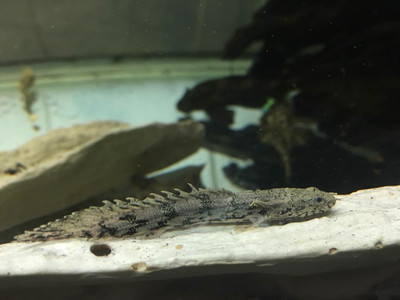Endlicheri Bichir
Posted by Max Gandara on on 9th Jul 2025
Endlicheri Bichir: A Living Fossil for Monster Fish Keepers
(Polypterus endlicheri endlicheri)
Looking to add something truly prehistoric and powerful to your freshwater setup? The Endlicheri Bichir is one of the most striking and robust members of the Polypterus family—famed for its large size, bold patterns, and ancient lineage. With its armored body and alert demeanor, this "dinosaur fish" makes a commanding centerpiece for any monster tank.
Quick Facts
-
Common Name: Endlicheri Bichir
-
Scientific Name: Polypterus endlicheri endlicheri
-
Origin: Central and West Africa (Nile, Chad, Niger, and Volta river basins)
-
Adult Size: Up to 24 inches
-
Temperament: Semi-aggressive, predatory
-
Lifespan: 15+ years with proper care
Appearance
Endlicheri Bichirs are known for their thick, eel-like bodies covered in heavy ganoid scales, pronounced dorsal finlets, and broad, shovel-like heads. Their patterning ranges from olive green to yellowish-tan, marked with bold, irregular blotches or bands across the body—giving each fish a unique, wild look.
Their eyes and sensory organs sit high on the head, allowing them to ambush prey at night or from the substrate.
Behavior & Temperament
These are nocturnal, bottom-dwelling fish with slow but deliberate movements. Despite their predatory nature, they are not overly aggressive toward tankmates that are too large to eat. They tend to ignore mid-to-top level fish, especially in spacious environments.
Endlicheri Bichirs are escape artists, so a tight-fitting, escape-proof lid is a must.
Tank Setup & Requirements
? Tank Size:
A minimum of 100 gallons is recommended for a juvenile, with larger systems needed as they grow. These fish demand horizontal swimming space and a large footprint.
? Water Parameters:
-
Temperature: 75–82°F
-
pH: 6.2–7.8
-
Hardness: Moderate
-
Good filtration and oxygenation are essential.
? Tank Decor:
-
Sandy or smooth gravel substrate
-
Driftwood, caves, and large rockwork for hiding
-
Dim lighting or floating plants to mimic their natural low-light habitat
Diet & Feeding
Endlicheri Bichirs are obligate carnivores. In the wild, they prey on fish, insects, and crustaceans. In captivity, they readily accept:
-
Frozen or live shrimp
-
Silversides
-
Earthworms
-
Carnivore pellets
-
Chopped fish fillet or krill
Feed 2–3 times per week, depending on age and size. Avoid overfeeding and remove uneaten food quickly.
Tankmates
Compatible with other large, peaceful to semi-aggressive fish that can’t be swallowed. Good companions include:
-
Large cichlids (e.g., Oscars, Severums)
-
Arowanas (in massive tanks)
-
Datnoids
-
Large catfish (e.g., Synodontis, larger Pimelodus)
Avoid small tankmates like tetras, guppies, or anything that fits in a Bichir’s mouth.
Breeding
Breeding Endlicheri Bichirs in captivity is rare and typically requires large, species-dedicated tanks. Males have broader anal fins and are generally slimmer than females. Spawning usually involves the male wrapping around the female to fertilize eggs that are scattered and fertilized externally.
Final Thoughts
The Endlicheri Bichir is not for everyone—but for aquarists seeking a truly prehistoric, bold, and interactive fish, it’s a showstopper. With proper care, space, and diet, this living fossil can thrive for decades and become the highlight of any large freshwater setup.

